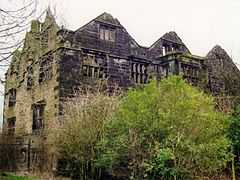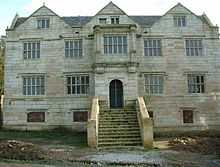Clegg Hall
| Clegg Hall | |
|---|---|
 Clegg Hall as it appeared in 1999 | |
 Location within Greater Manchester | |
| General information | |
| Town or city | Littleborough, Greater Manchester |
| Country | England |
| Coordinates | 53°37′36″N 2°07′03″W / 53.626605°N 2.117423°W |
| Completed | 1610 |
| Client | Theophilus Aston |
Clegg Hall is a 17th-century hall in Littleborough, Greater Manchester (grid reference SD92231448).[1] It is situated just outside Smithy Bridge, Greater Manchester.
The "Clegg" in the name of the current hall refers to the location (Little Clegg or Great Clegg) rather than the local family by the same surname – the house was built by a Theophilus Ashton in the early 17th century, and it has never been suggested that the house has been lived in by Cleggs.[2] It appears to be on the site of an earlier Clegg Hall(s) whose occupants were Cleggs.
According to Oakley's highly romanticised version,[3] the first known Cleggs, Bernulf (and his wife Quernilda) de Clegg were in the Domesday book, though they are more commonly said to date to King Stephen's reign (1135–1154). That would seem sensible dating from the names, as they are all Anglo Saxon apart from the "de" which is a Norman addition, typical of the period before Norman Christian names became common.
Clegg Hall was designated a Grade II* listed building in 1951.[4]
Boggart
Clegg Hall is reputed to be haunted. The Clegg Hall boggart (as the ghost is better known) is usually placed in the 13th century. The longest version is a fictionalized account in a book called In Olden Days written by a local vicar (Revd. Oakley)[3] in the early years of this century. It reckoned that the master of the house went off to France to fight with Henry. While the father was away the wicked uncle killed both his nephews, throwing them over the battlements into the moat of what was presumably a fortified house. Eventually the father returned. His brother crept through a secret passage from a nearby hall (possibly Stubley Old Hall), ready to do away with the distraught father, when one of the children's voices was heard calling out "Father beware!" (or words to that effect) and the father awoke, sending his evil brother running terrified to plunge to his death. Ever since, allegedly, the phantom boy has been heard issuing warnings.
The current building was described in a 1626 survey of Rochdale as "a faire capital messuage built with free stone with all new fair houses of office there-unto belonging with gardens, fishponds and divers closes of land". It also refers to "barns, stables, courts, orchards, gardens, folds and pigeon houses".
At least two books refer to the ghost and later uses of the current building. One is Harland and Wilkinson's Lancashire Legends, originally published in 1873.[5] This says: "After many changes of occupants it is now in part used as a country alehouse; other portions of it are inhabited by the labouring classes, who find employment in that populous manufacturing district. It is the property of the Fentons, by purchase from the late John Entwisle Esq of Foxholes." The other, Lancashire Legends by Katherine Eyre (1972), says that from 1818 to 1869 it was a public house called the Horse and Hounds, but generally known as the Black Sloven, the name of a favourite hunting mare of legendary speed which belonged to the former owner, Mr Charles Turner. He died in 1733. It says that "The Boggart Chamber" became a place to be avoided, although it is not clear if this was in the pre-1620s house or not. It is alleged that a young girl was playing hide and seek and she was found dead behind a wall and a curtain. It also says that "during the Commonwealth era, there were hints of counterfeiting activities in the vaults and cellars of Clegg Hall"; it was common for smugglers and counterfeiters of the period to use tales of ghosts to scare off locals.
Ruin and restoration

Some time in the early 1900s there was a fire at the hall which caused severe damage. A picture in Oakley's 1910 edition of In Olden Days shows it as a complete building.[3] However, the text of a 1920s edition describes it as "a ruined hall", so the damage must have been done sometime during that period. It was left in ruins until its 20th-century restoration. A local resident remembers playing there in the 1950s, when the upper floors were still present, and a farmer used the ground floor to house his cows. Some time between the 1970s and 1999, the most impressive external feature – the portico from the front door – was removed.
In the late 1980s, following the building's purchase by the environmental organization Pennine Heritage, rumours of a large-scale theme park centred on the hall led to the formation of a local residents' group to petition councillors for assurances their properties would not be compulsorily purchased. At one point there was a suggestion that Clegg Hall, which is near the Rochdale Canal, could be turned into a museum, but this proved too expensive.
Clegg Hall has been restored to its pre-1900 condition. It is not open to the public. Exterior restoration was completed early in 2008, appearing to be a restored shell with industrial gated front doors and no landscaping. By November 2012 the external restoration has been matched by internal restoration. Clegg Hall is privately owned.
See also
References
- ↑ "Clegg Hall". Pastscape.org.uk. Retrieved 2008-04-23.
- ↑ Eyre, K: "Lancashire Legends". Dalesman Publishing, 1972
- ↑ 3.0 3.1 3.2 Oakley, G. F.: "In Olden Days". Unknown Publisher, 1910
- ↑ "Clegg Hall". Images of England. Retrieved 2007-12-18.
- ↑ John Harland and Turner Wilkinson: "Lancashire Legends". EP, 1973